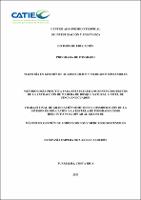Mostrar el registro sencillo del ítem
Metodología práctica para establecer los beneficios brutos de la extracción demadera de bosque natural a nivel de finca en Ecuador
| dc.contributor.advisor | Valera Mejias, Vladimir J | |
| dc.contributor.author | Arias Calderón, Estefania E | |
| dc.contributor.other | CATIE - Centro Agronómico Tropical de Investigación y Enseñanza | |
| dc.coverage.spatial | Turrialba, Costa Rica | |
| dc.date.accessioned | 2014-10-17T05:51:27Z | |
| dc.date.available | 2014-10-17T05:51:27Z | |
| dc.date.issued | 2023 | es_ES |
| dc.identifier | 344768 | es_ES |
| dc.identifier.uri | https://repositorio.catie.ac.cr/handle/11554/227 | |
| dc.description | Tesis (Mag.) –CATIE, Turrialba (Costa Rica), 2023 | es_ES |
| dc.description.abstract | El presente estudio desarrolló una metodología práctica para la determinación de los beneficios brutos de la extracción de madera en los bosques naturales a nivel de finca, en Ecuador. Para el juste de los coeficientes se analizó una fuente primaria compuesta de 286encuestas realizadas a operaciones forestalespor el Ministerio d Ambiente, Agua y Transición Ecológica (MAATE), durante el periodo 2017-2018. Los diferentes coeficientes que forman parte de la metodología de beneficios brutos se plasmaron en herramienta ForesTool. Como parte del estudio, se validó el grado de ajuste de la metodologíapropuestamediante su aplicación a través deherramienta ForesTool en dos operaciones forestalesque estaban en su fase de cierre. Los principales hallazgos del estudio muestran que la estructura de la metodologíapropuesta que considera actividades de legalización, aserrado, tumbado, barqueo y movilización se ajusta a la realidad de la extracción de madera en bosques naturales(no industrial). Debido a los pocos casosen que se validóla herramienta no se puede determinar con exactitud que el coeficiente es inadecuado, por lo cual es necesario incrementar la muestra de la validación para llegar a conclusiones con menor incertidumbre. | es_ES |
| dc.description.abstract | The present study developed a practical methodology for the determination of the gross benefits of the extraction of wood in natural forests at the farm level in Ecuador. To adjust the coefficients, a primary source composed of 286 surveys carried out on forestry operations by the Ministry of Environment, Water and Ecological Transition (MAATE) was analyzed during the 2017-2018 period. The different coefficients that are part of the gross profit methodology were captured in the Festool tool. s part of the study, the degree of adjustment of the proposed methodology was validated through its application through the ForesTool in two forestry operationsin their closing phase. The study's main findings show that the structure of the proposed methodology, which considers legalization, sawing, felling, boating, and mobilization activities, adjusts to the reality of logging in natural (non-industrial) forests. Due to the few cases in which the tool was validated, it cannot be determined exactly that the coefficient is inadequate. It is necessary to increase the validation sample to reach conclusions with less uncertainty. | |
| dc.format.extent | 74 páginas | |
| dc.language.iso | es | es_ES |
| dc.publisher | Centro Agronómico Tropical de Investigación y Enseñanza (CATIE) | es_ES |
| dc.relation.ispartof | Maestría en Gestión de Agronegocios y Mercados Sostenibles | |
| dc.rights | info:eu-repo/semantics/openAccess | es_ES |
| dc.subject | BEST PRACTICES | |
| dc.subject | BENEFICIO BRUTO | |
| dc.subject | GROSS MARGINS | |
| dc.subject | APROVECHAMIENTO DE LA MADERA | |
| dc.subject | LOGGING | |
| dc.subject | ECUADOR | |
| dc.subject | ForestToolMEJOR PRÁCTICA | |
| dc.title | Metodología práctica para establecer los beneficios brutos de la extracción demadera de bosque natural a nivel de finca en Ecuador | es_ES |
| dc.type | Tesis de maestría | es_ES |
Ficheros en el ítem
Este ítem aparece en la(s) siguiente(s) colección(ones)
-
Tesis [1392]


